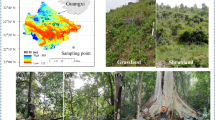Abstract
Effects of human trampling and multispecies competition on the development of a tread community in the first year were examined by comparing changes in the relative abundance of three main component species of tread communities,Plantago asiatica, Eragrostis ferruginea andEleusine indica, between monoculture and mixed culture along a trampling gradient. At low trampling levels in mixed culture,Ambrosia artemisiifolia var.elatior andDigitaria adscendens, which are common pioneer species of secondary succession, predominated and suppressed the tread community species. Severe trampling reduced markedly the predominance of the pioneer species, but not that of the tread community species. The maximum cover of the three tread commiunty species was lower in mixed culture than in monoculture. The trampling levels supporting the maximum cover were higher in mixed culture than in monoculture. The differences in these levels between monoculture and mixed culture varied among the three:P. asiatica< Eragrostis ferruginea<Eleusine indica. These results suggest that (1) the pioneer species interfere with the establishment of tread community species under lower trampling intensity, (2) heavier trampling reduces the competitive ability of pioneer species, while it favors the establishment of tread community species, (3), there are competitive interactions among the tread community species under higher trampling intensity, and (4) the species more susceptible to multispecies competition and tolerant to trampling are established in more heavily trampled habitats.
Similar content being viewed by others
References
Austin, M. P. &Austin, B. O. (1980) Behaviour of experimental plant communities along a nutrient gradient. J. Ecol.68: 891–918.
Austin, M. P., Groves R. H., Fresco, L. M. F. &Kaye, P. E. (1985) Relative growth of six thistle species along a nutrient gradient with multispecies competition. J. Ecol.73: 667–684.
Bates, G. H. (1935) The vegetation of footpaths, sidewalks, cart-tracks and gateways. J. Ecol.23: 470–487.
Bates, G. H. (1938) Life forms of pasture plants in relation to treading. J. Ecol.26: 452–454.
Connell, J. H. (1978) Diversity in tropical rain forests and coral reefs. Science199: 1302–1310.
Connell, J. H. (1983) On the prevalence and relative importance of interspecific competition: Evidence from field experiments. Am. Nat.122: 661–696.
Crawley, M. J. (1986) Life history and environment. “Plant ecology” (ed. Crawley, M. J.), 253–290. Blackwell, Oxford.
Dayton, P. K. (1975) Experimental evaluation of ecological dominance in a rocky intertidal algal community. Ecol. Monogr.45: 137–159.
Ellenberg, H. (1953) Physiologisches und ökologisches Verhalten derselben Pflanzenarten. Ber. Deut. Botan. Ges.65: 351–362.
Ellenberg, H. (1954) Über einige Fortschritte der kausalen Vegetationskunde. Vegetatio5/6: 199–211.
Ellenberg, H. (1988) Vegetation ecology of central Europe, 4th ed. 731 pp. Cambridge Univ. Press, Cambridge.
Fenner, M. (1980) The inhibition of germination ofBidens pilosa seeds by leaf canopy shade in some natural vegetation types. New Phytol.84: 95–101.
Fowler, N. (1986) The role of competition in plant communities in arid and semiared regions. Ann. Rev. Ecol. Syst.17: 89–110.
Grace, J. B. &Wetzel, R. G. (1981) Habitat partitioning and competitive displacement in cattails (Typha): Experimental field studies. Am. Nat.242: 463–474.
Grime, J. P. (1973) Competitive exclusion in herbaceous vegetation. Nature242: 344–347.
Grime, J. P. (1977) Evidence for the existence of three primary strategies in plants and its relevance to ecological and evolutionary theory. Am. Nat.111: 1169–1194.
Grime, J. P. (1979) Plant strategies and vegetation processes. 222 pp. John Wiley, Chichester.
Grubb, P. J. (1977) The maintenance of species richness in plant communities: The importance of regeneration niche. Biol. Rev.52: 107–145.
Hayashi, I. (1977) Secondary succession of herbaceous communities in Japan. Jpn., J. Ecol.27: 191–200.
Huston, M. (1979) A general hypothesis of species diversity. Am. Nat.113: 81–101.
Keddy, P. A. (1989) Competition 202 pp. Chapman & Hall, London.
Knapp, R. (1954) Experimentelle Soziologie der höheren Pflanzen. 202 pp. Eugen Ulmer, Stuttgart.
Kondo, M., &Ozawa, T. (1977) Fundamental studies on the carrying capacity of lawns and lawns-area: (I) Calculation of carrying capacity of lawns, as a clue to elucidate the resistant properties of vegetation against soil hardness owing to trampling. J. Jpn. Inst. Landscape Archit.40: 11–23 (In Japanese with English summary).
Miller, T. E. &Werner, P. A. (1987) Competitive effects and responses between plant species in a first-year old-field community. Ecology68: 1201–1210.
Miyawaki, A. (1964) Trittgesellschaften auf den japanischen Inseln. Bot. Mag. Tokyo77: 365–374.
Mueller-Dombois, D. &Ellenberg, H. (1974) Aims and methods of vegetation ecology. 547 pp. Wiley, New York.
Numata, M. (1956) The developmental process of weed communities: Experimental studies on early stages of a secondary succession II. Jpn. J. Ecol.6: 62–66, 89–93 (In Japanese with English summary).
Numata, M. &Yamai, H. (1955) The developmental process of weed communities: Experimental studies on early stages of a secondary succession I. Jpn. J. Ecol.4: 166–171 (In Japanese with English summary).
Okuda, S. (1978) Pflazensoziologische Untersuchungen über die Auenvegetation der Kanto-Ebene. Bull. Inst. Environ. Sci. Techn. Yokohama Nation. Univ.4: 43–112 (In Japanese with English and German summary).
Okuda, S. (1986) Trittgesellschaften. “Vegetation of Japan: Kanto” (ed. Miyawaki, A.), 269–272. Shibundo, Tokyo (In Japanese).
Okutomi, K., Okuda, S., Tsuji, S. &Hoshino, Y. (1987) Vegetation of Tokyo. “Studies on the vegetation of Tokyo”, 13–254. Tokyo Metropolitan Government, Tokyo (In Japanese with English summary).
Rice, E. L. (1974) Allelopathy. 353 pp. Academic Press, New York.
Schoener, T. W. (1983) Field experiments on interspecific competition. Am. Nat.122: 240–285.
Sousa, W. P. (1984) The role of disturbance in natural communities. Ann. Rev. Ecol. Syst.15: 353–391.
Tokyo District Meteorological Observatory (1986, 1987) Annual report of meteorology, Tokyo Metropolis (In Japanese).
Tüxen, R. (1977) Pflanzensoziologische Bemerkungen zu japanischen Trittgesellschaften. “Vegetation science and environmental protection”, (ed. Miyawaki, A. & Tüxen, R.), 567–573. Maruzen, Tokyo.
Washitani, I. &Saeki, T. (1984) Leaf-canopy inhibition of germination as a mechanism for the disappearance ofAmaranthus patulus Bertol. in the second year of a secondary succession. Jpn. J. Ecol.34: 55–61.
Wilson, S. D. &Keddy, P. A. (1986) Species competitive ability and position along a natural stress/disturbance gradient. Ecology67: 1236–1242.
Author information
Authors and Affiliations
About this article
Cite this article
Ikeda, H., Okutomi, K. Effects of human trampling and multispecies competition on early-phase development of a tread community. Ecol. Res. 5, 41–54 (1990). https://doi.org/10.1007/BF02348462
Accepted:
Issue Date:
DOI: https://doi.org/10.1007/BF02348462




